
Chin J Dent Res 2016;19(1):9–16; doi: 10.3290/j.cjdr.a35692
人类乳头状瘤病毒(HPV)与口咽癌:以史为鉴
Human Papilloma Virus and Oropharyngeal Carcinoma – Lessons from History
Alexander Chris VLANTIS
本文由来自香港中文大学威尔士王子医院的Alexander Chris VLANTIS医生为我们介绍了人类乳头状瘤病毒(HPV)与口咽癌关系的历史经验。
HPV是一种常见的病毒,世界上10%的人口的上皮组织都受到其感染。除大部分性活跃的人群已被感染外,还有很多健康人群携带并用机体免疫力控制着感染。
HPV在宫颈黏膜的感染比较顽固,与几乎所有的宫颈癌相关。幸运的是,宫颈癌筛查的敏感性和特异性都很高,可以显著降低宫颈癌的发病率。虽然如此,宫颈癌仍是导致癌症死亡的主要原因之一。
越来越多人的口咽黏膜受到HPV的持续感染,导致口咽癌的潜在增长,在有吸烟史的老年男性当中尤为明显。
有研究中心报道70%的口咽癌与HPV感染相关,独立于饮酒和吸烟这些危险因素,也有一些中心报告仅有20%相关。
目前,对高危患者的教育尚不到位,口咽腔HPV感染的检出率也仅有40%。未来在唾液和血浆中检测病毒DNA可能是更有效的检测手段。HPV疫苗从2006年起就已上市,但在很多国家都尚未开始常规使用。HPV阳性的口咽癌发病率目前尚不明确。医务人员需对此疾病高度重视。
Chin J Dent Res 2016;19(1):9–16; doi: 10.3290/j.cjdr.a35692
Human Papilloma Virus and Oropharyngeal Carcinoma – Lessons from History
Alexander Chris VLANTIS1
The human papilloma virus (HPV) is a common virus that infects epithelium in 10% of the world’s population. While most sexually active people become infected, the majority with a healthy natural immunity control their infection. When the infection becomes persistent in cervical mucosa for instance, it is associated with nearly all cervical cancers. Fortunately cervical cancer screening is both sensitive and specific and when accessed has led to significant reductions of this disease. Despite this, cervical cancer still remains one of the leading causes of death from cancer. Oropharyngeal mucosa is becoming persistently infected with HPV in an increasing number of people leading to a potential epidemic of oropharyngeal carcinoma. While only 10% of new oropharyngeal infections persist, those in elderly men who smoke are more likely to do so. Some centres report more than 70% of oropharyngeal cancers are associated with HPV infection, which is different to cancers caused by alcohol and tobacco. Other centres report only a 20% association. Education against high-risk sexual behaviour has been met with limited success. Screening for oropharyngeal HPV infection has been disappointing with a pickup rate of only 40%. Some hope lies in detecting viral DNA in both the saliva and plasma. A HPV vaccine has been available since 2006 but is not yet routinely given to both sexes in many countries. Its effect on the incidence of HPV-positive oropharyngeal carcinomas is currently unknown. Vigilance by dental and medical colleagues in the meantime is essential.
Key words: cervical carcinoma, human papilloma virus, oropharyngeal carcinoma, screening, vaccination
来源:中华口腔医学会

